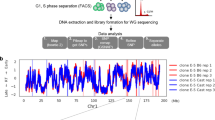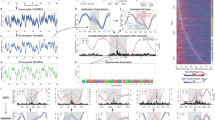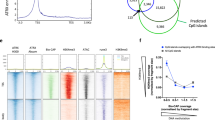Abstract
Imprinting marks the parental origin of chromosomes, resulting in allele–specific changes in chromatin organization, transcription and replication. We report a 50–60 kb domain of allele–specific replication between the γ–aminobutyric acid receptor subunit β3 (GABRB3) and α5 (GABRA5) genes. Replication of this domain occurs in early S phase on the maternal chromosome 15 but is delayed until the end of S phase on the paternal homologue. In contrast, the genomic regions flanking this domain exhibit paternal earlier replication in mid to late S phase. Uniparental disomy or hemizygous deletion of chromosome 15 results in altered allele–specific replication kinetics compared with normals, suggesting that allele–specific replication within the GABRB3/A5 region may be regulated by reciprocal imprints on the maternal and paternal chromosomes.
This is a preview of subscription content, access via your institution
Access options
Subscribe to this journal
Receive 12 print issues and online access
$209.00 per year
only $17.42 per issue
Buy this article
- Purchase on Springer Link
- Instant access to full article PDF
Prices may be subject to local taxes which are calculated during checkout
Similar content being viewed by others
References
Crouse, H.V. The controlling element in sex chromosome behavior in Sciara. Genetics 45, 1429–1443 (1960).
McGrath, J. & Solter, D. Completion of mouse embryogenesis requires both the maternal and paternal genomes. Cell 37, 179–183 (1984).
Surani, M.A.H., Barton, S.C. & Norris, M.L. Development of reconstituted mouse eggs suggests Imprinting of the genome during gametogenesis. Nature 308, 548–550 (1984).
Barlow, D.P., Stoger, R., Herrmann, B.G., Saito, K. & Schweifer, N. The mouse Insulin-like growth factor type-2 receptor Is Imprinted and closely linked to the Time locus. Nature 349, 84–87 (1991).
Bartolomei, M.S., Zemel, S. & Tilghman, S.M. Parental imprinting of the mouse H19 gene. Nature 351, 153–155 (1991).
DeChlara, T.M., Robertson, E.J. & Efstratiadis, A. Parental imprinting of the mouse insulin-like growth factor II gene. Cell 64, 849–859 (1991).
Rainier, S. et al. Relaxation of Imprinted genes in human cancer. Nature 362, 747–749 (1993).
Ohisson, R. et al. Igf2 is parentally imprinted during human embryogenesis and in the Beckwlth-Wiedemann syndrome. Nature Genet. 4, 94–97 (1993).
Zhang, Y. & Tyko, B. Monoalleleic expression of the human H19 gene. Nature Genet. 1, 40–44 (1992).
Butler, M.G. & Palmer, C.G. Parental origin of chromosome 15 deletion In Prader-Willl syndrome. Lancet i, 1285–1286 (1983).
Nicholls, R.D., Knoll, J.H.M., Butler, M.G., Karam, S. & Lalande, M. Genetic imprinting suggested by maternal heterodisomy in non-deletion Prader-Willl syndrome. Nature 342, 281–285 (1989).
Knoll, J.H.M. et al. Angelman and Prader-Willl syndromes share a common chromosome 15 deletion but differ In parental origin of the deletion. Am. J. Med. Genet. 32, 285–290 (1989).
Malcolm, S. et al. Uniparental paternal disomy In Angelman's syndrome. Lancet 337, 694–697 (1991).
Wagstaff, J. et al. Maternal but not paternal transmission of 15q11-13-llnked nondeletion Angelman syndrome leads to phenotypic expression. Nature Genet. 1, 291–294 (1992).
Cattanach, B.M. et al. A candidate mouse model for Prader-Willi syndrome which shows an absence of Snrpn expression. Nature Genet. 2, 270–274 (1992).
Leff, S.E. et al. Maternal Imprinting of the mouse Snrpn gene and conserved linkage homology with the human Prader-Willi syndrome region. Nature Genet. 2, 259–264 (1992).
Özcelik, T. et al. Small nuclear ribonucleoprotein polypeptide N (SNRPN), an expressed gene in the Prader-Willi syndrome critical region. Nature Genet. 2, 265–269 (1992).
Reed, M.L. & Leff, S.E. Maternal imprinting of human SNRPN, a gene deleted in Prader-Willi syndrome. Nature Genet. 6, 163–167 (1994).
Sutcliffe, J.S. et al. Deletions of a differentially methylated CpG Island at the SNRPN gene define a putative imprinting control region. Nature Genet. 8, 52–58 (1994).
Wevrick, R., Kerns, J.A. & Franke, U. Identification of a novel paternally expressed gene In the Prader-Willi syndrome region. Hum. molec. Genet. 3, 1877–1882 (1994).
Kitsberg, D. et al. Allele-specific replication timing of Imprinted gene regions. Nature 364, 459–463 (1993).
Knoll, J.H.M., Cheng, S.D. & Lalande, M. Allele specificity of DNA replication timing in the Angelman/Prader-Willi syndrome Imprinted chromosomal region. Nature Genet. 6, 41–45 (1994).
Selig, S., Okumura, K., Ward, D.C. & Cedar, H. Delineation of DNA replication time zones by fluorescence In situ hybridization. EMBO J. 11, 1217–1225 (1992).
Torchia, B.S., Call, L.M. & Migeon, B.R. DNA replication analysis of FMR1, XIST, and factor 8C loci by FISH shows nontranscribed X-linked genes replicate late. Am. J. hum. Genet. 55, 96–104 (1994).
Boggs, B.A. & Chinault, A.C. Analysis of replication timing properties of human X-chromosomal loci by fluorescence in situ hybridization. Proc. natn. Acad. Sci. U.S.A. 91, 6083–6087 (1994).
Chess, A., Simon, I., Cedar, H. & Axel, R. Allelic inactivation regulates olfactory receptor gene expression. Cell 78, 823–634 (1994).
Sinnett, D. et al. High-resolution mapping of the g-aminobutyric acid receptor subunit β3 and a5 gene cluster on chromosome 15q11–q13 and localization of breakpoints in two Angelman syndrome patients. Am. J. hum. Genet. 52, 1216–1229 (1993).
Hassan, A. & Cook, P.R. Does transcription by RNA polymerase play a direct role In the initiation of replication? J. Cell Sci. 107, 1381–1387 (1994).
Judd, B.H., Allelic cross talk. Cell 53, 841–843 (1988).
Pirrotta, V. Transvection and long-distance gene regulation. BioEssays 12, 409–414 (1990).
Tsai, J.-Y. & Silver, L.M. Escape from genomic imprinting at the mouse T-associated maternal effect (Tme) locus. Genetics 129, 1159–1166 (1991).
Latham, K.E., Doherty, A.S., Scott, C.D. & Schultz, R.M. lgf2r and Igf2 gene expression in androgenetic, gynogenetic, and parthenogenetic preimplantation mouse embryos: absence of regulation by genomic imprinting. Genes Dev. 8, 290–299 (1994).
Mutter, G.L., Stewart, C.L., Chaponot, M.L. & Pomponio, R.J., Oppositely Imprinted genes H19 and insulin-like growth factor 2 are coexpressed in human androgenetic trophoblast. Am. J. hum. Genet. 53, 1096–1102 (1993).
Kay, G.F., Barton, S.C., Surani, A. & Rastan, S. Imprinting and X chromosome counting mechanisms determine Xist expression in early mouse development. Cell 77, 629–650 (1994).
Barlow, D.P. Imprinting: a gamete's point of view. Trends Genet. 10, 194–199 (1994).
Bottani, A. et al. Angelman syndrome due to paternal uniparental disomy of chromosome 15: A milder phenotype? Am. J. med. Genet. 51, 35–40 (1994).
Robinson, W.P. et al. Nondisjunction of chromosome 15: Origin and recombination. Am. J. hum. Genet. 53, 740–751 (1993).
LaSalle, J.M., Tolentino, P.J., Freeman, G.L., Nadler, L.M. & Hafler, D.A. Early signaling defects in human T cells anergized by T cell presentation of autoantigen. J. exp. Med. 176, 177–186 (1994).
Arndt-Jovin, D.J. & Jovin, T.M. Analysis and sorting of living cells according to deoxyribonucleic acid content. J. histochem. Cytochem. 25, 585–589 (1977).
Crissman, H.A., Hofland, M.H., Stevenson, A.P., Wilder, M.E. & Tobey, R.A. Use of DiO-C5. -3 to Improve Hoechst 33342 uptake resolution of DNA content and survival of CHO cells. Exp. Cell Res. 174, 388–396 (1994).
Author information
Authors and Affiliations
Rights and permissions
About this article
Cite this article
LaSalle, J., Lalande, M. Domain organization of allele–specific replication within the GABRB3 gene cluster requires a biparental 15q11–13 contribution. Nat Genet 9, 386–394 (1995). https://doi.org/10.1038/ng0495-386
Received:
Accepted:
Issue Date:
DOI: https://doi.org/10.1038/ng0495-386
This article is cited by
-
Microdeletion syndromes disclose replication timing alterations of genes unrelated to the missing DNA
Molecular Cytogenetics (2009)
-
Aberrant allele-specific replication, independent of parental origin, in blood cells of cancer patients
BMC Cancer (2008)
-
Replication in context: dynamic regulation of DNA replication patterns in metazoans
Nature Reviews Genetics (2007)
-
Replication profile of PCDH11X and PCDH11Y, a gene pair located in the non-pseudoautosomal homologous region Xq21.3/Yp11.2
Chromosome Research (2007)
-
Asynchronous replication of imprinted genes is established in the gametes and maintained during development
Nature (1999)



